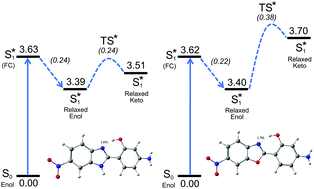Experimental and theoretical investigation of long-wavelength fluorescence emission in push–pull benzazoles: intramolecular proton transfer or charge transfer in the excited state?†
Abstract
This study presents the synthesis, characterisation and theoretical calculations of compounds that contain electron donor and withdrawing groups connected through a π-conjugated benzazolic structure. The compounds in solution show an absorption maximum in the UV-visible spectrum (380–390 nm) due to spin and symmetry allowed electronic 1ππ* transitions with no clear evidence for charge transfer in either compound in the ground state. A fluorescence emission located in the violet-blue-green region, tailored by solvent polarity, with a large Stokes shift was observed. Taking the long-wavelength emission into account, the Lippert–Mataga plot indicates a positive solvatochromism in the solvent polarity function (Δf) range 0.02–0.20, related to the occurrence of an ICT mechanism in the excited state. At Δf greater than 0.20, the polarity of the medium seems no longer to increase the stabilization of the compounds, reaching a plateau. Time-dependent density functional theory (TD-DFT) and resolution-of-identity second-order approximate coupled-cluster (RI-CC2) calculations were also used to better understand the excited state of these compounds. The results indicated that ESIPT was disfavoured in the compounds, mainly in polar solvents, and the emission wavelengths were primarily associated with ICT. In summary, in these push–pull compounds, the electron donating and withdrawing groups do not favour the ESIPT process.

- This article is part of the themed collection: Celebrating Latin American Talent in Chemistry


 Please wait while we load your content...
Please wait while we load your content...